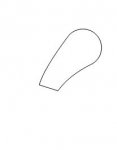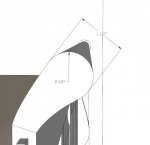Aaron Beaver
Member
- Messages
- 427
- Location
- Missouri
Just getting a head start on this issue.
I am going to build a bed for my daughter and this is what the top rail for the foot board needs to look like. It's a full sized bed, so 5 feet long or so.
How would you make this piece? It's 3/4" thick at the bottom, maybe 1.5" thick at the thickest, but doesn't really matter, how would you get this shape down the entire length of this piece?
Just trying to determine if I am going to have to save up to buy something (bits or otherwise) to make this piece.
I can post a picture of what it will look like on the bed later, just don't have it with me right now.
Thanks
I am going to build a bed for my daughter and this is what the top rail for the foot board needs to look like. It's a full sized bed, so 5 feet long or so.
How would you make this piece? It's 3/4" thick at the bottom, maybe 1.5" thick at the thickest, but doesn't really matter, how would you get this shape down the entire length of this piece?
Just trying to determine if I am going to have to save up to buy something (bits or otherwise) to make this piece.
I can post a picture of what it will look like on the bed later, just don't have it with me right now.
Thanks



